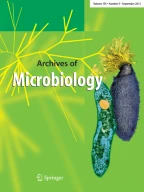293Accesses
3Altmetric
Abstract
Thermoproteus tenax is a hyperthermophilic, facultative heterotrophic archaeum. In this organism the utilization of the two catabolic pathways, a variant of the Embden-Meyerhof-Parnas (EMP) pathway and the modified (nonphosphorylative) Entner-Doudoroff (ED) pathway, was investigated and the first enzyme of the ED pathway, glucose dehydrogenase, was characterized. The distribution of the13C label in alanine synthesized by cells grown with [1-13C]glucose indicated that in vivo the EMP pathway and the modified ED pathway operate parallel, with glucose metabolization via the EMP pathway being prominent. To initiate studies on the regulatory mechanisms governing carbon flux via these pathways, the first enzyme of the ED pathway, glucose dehydrogenase, was purified to homogeneity and its phenotypic properties were characterized. The pyridine-nucleotide-dependent enzyme used both NAD+ and NADP+ as cosubstrates, showing a 100-fold higher affinity for NADP+. Besides glucose, xylose was used as substrate, but with significantly lower affinity. These data suggest that the physiological function of the enzyme is the oxidation of glucose by NADP+. A striking feature was the influence of NADP+ and NAD+ on the quaternary structure and activity state of the enzyme. Without cosubstrate, the enzyme was highly aggregated (mol. mass > 600 kDa) but inactive, whereas in the presence of the cosubstrate the aggregates dissociated into enzymatically active, homomeric dimers with a mol. mass of 84 kDa (mol. mass of subunits: 41 kDa). The N-terminal amino acid sequence showed striking similarity to the respective partial sequences of alcohol dehydrogenases and sorbitol dehydrogenases, but no resemblance to the known pyridine-nucleotide-dependent archaeal and bacterial glucose dehydrogenases.
This is a preview of subscription content,log in via an institution to check access.
Access this article
Subscribe and save
- Get 10 units per month
- Download Article/Chapter or eBook
- 1 Unit = 1 Article or 1 Chapter
- Cancel anytime
Buy Now
Price includes VAT (Japan)
Instant access to the full article PDF.
Similar content being viewed by others

A GTP-driven central carbon metabolism in the cellulolytic bacteriumRuminiclostridium cellulolyticum
Author information
Authors and Affiliations
FB 9 Mikrobiologie, Universität GH Essen, Universitätsstrasse 5, D-45117 Essen, Germany Tel. +49-201-1833442; Fax +49-201-1832529 e-mail: bettina.siebers@uni-essen.de, , , , , , DE
B. Siebers & Reinhard Hensel
Institut für Biotechnologie 1, Forschungszentrum Jülich, D-52425 Jülich, Germany, , , , , , DE
Volker F. Wendisch
- B. Siebers
You can also search for this author inPubMed Google Scholar
- Volker F. Wendisch
You can also search for this author inPubMed Google Scholar
- Reinhard Hensel
You can also search for this author inPubMed Google Scholar
Additional information
Received: 25 October 1996 / Accepted: 15 April 1997
Rights and permissions
About this article
Cite this article
Siebers, B., Wendisch, V. & Hensel, R. Carbohydrate metabolism in Thermoproteus tenax: in vivo utilization of the non-phosphorylative Entner-Doudoroff pathway and characterization of its first enzyme, glucose dehydrogenase.Arch Microbiol168, 120–127 (1997). https://doi.org/10.1007/s002030050477
Issue Date:

